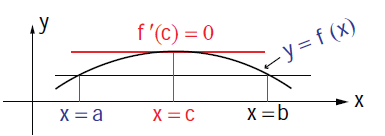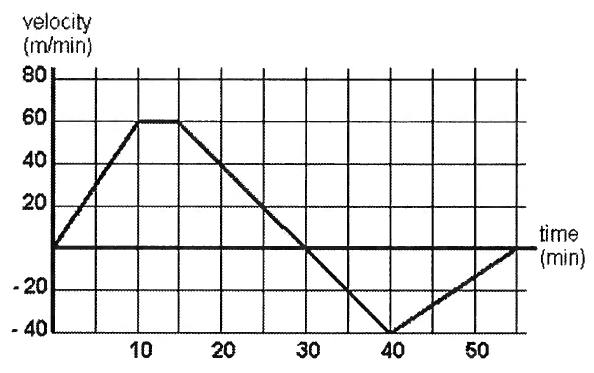WHY ROLLES THEOREM IS NOT APPLICABLE FOR THE GIVEN FUNCTION
Let f (x) be continuous on a closed interval [a, b] and differentiable on the open interval (a, b)
If f(a) = f(b)
then there is at least one point c ∈ (a,b) where f '(c) = 0.
Geometrically this means that if the tangent is moving along the curve starting at x = a towards x = b then there exists a c ∈ (a, b) at which the tangent is parallel to the x -axis.

Explain why Rolle’s theorem is not applicable to the following functions in the respective intervals.
Problem 1 :
f(x) = |(1/x)|, x ∊ [-1, 1]
Solution :
The function is not defined at the interval [-1, 1], because when we apply x = 0, we get
f(0) = |1/0|
f(0) = ∞
So, rolle's theorem is not applicable for the given function.
Problem 2 :
f (x) = tan x, x ∊ [0, π]
Solution :
The function is not defined at the interval [0, π], because when we apply x = π/2, we get
f(π/2) = tan (π/2)
f(π/2) = ∞
So, rolle's theorem is not applicable for the given function.
Problem 3 :
f(x) = x - 2 log x, x ∊ [2, 7]
Solution :
f(x) = x - 2 log x
f(x) is defined and continuous on the interval [2, 7] and differentiable on (2, 7).
f(x) = x - 2 log x
|
f(2) = 2 - 2 log 2 f(2) = 2 - log 22 f(2) = 2 - log 4 ----(1) |
f(7) = 7 - 2 log 7 f(7) = 2 - log 72 f(7) = 2 - log 49 ----(2) |
f(2) ≠ f(7)
(1) ≠ (2)
So, rolle's theorem is not applicable for the given function.
For each problem, determine if the Rolle's Theorem can be applied. If it can, find all values of c that satisfy the theorem. If it cannot, explain why not
Problem 4 :
y = (-x2 + 1)/3x [1, 6]
Solution :
i) The given function y is defined and continuous on the closed interval [1, 6].
ii) Let f(x) = y = (-x2 + 1)/3x
u = -x2 + 1 and v = 3x
u' = -2x + 0 and v' = 3(1)
u' = -2x and v' = 3
d(u/v) = (vu' - uv')/v2
= [3x(-2x) - (-x2 + 1)3] / (3x)2
= [-6x2 + 3x2 - 3] / 9x2
= (-3x2 - 3)/ 9x2
= 3(-x2 - 1) / 9x2
= (-x2 + 1) / 3x2
It is differentiable in the open interval (1, 6)
iii) f(x) = (-x2 + 1)/3x
f(1) = (-x2 + 1)/3x
= (-12 + 1)/3(1)
= 0 ----(1)
f(6) = (-62 + 1)/3(6)
= (-36 + 1)/18
= -35/8 ----(2)
(1) and (2) are not equal.
Since the condition is not satisfied, rolle's theorem does not exists.
Problem 5 :
y = (x2 - x - 12)/(x + 4) [-3, 4]
Solution :
i) The given function y is defined and continuous on the closed interval [-3, 4].
ii) Let f(x) = y = (x2 - x - 12)/(x + 4)
u = x2 - x - 12 and v = x + 4
u' = 2x - 1 - 0 and v' = 1 + 0
u' = 2x - 1 and v' = 1
d(u/v) = (vu' - uv')/v2
= [(x + 4)(2x - 1) - (x2 - x - 12)1] / (x + 4)2
= [(2x2 - x + 8x - 4) - (x2 - x - 12)] / (x + 4)2
= [2x2 + 7x - 4 - x2 + x + 12] / (x + 4)2
= (x2 + 8x + 8) / (x + 4)2
It is differentiable in the open interval (-3, 4)
iii) f(x) = (x2 - x - 12)/(x + 4)
f(-3) = ((-3)2 - (-3) - 12)/(-3 + 4)
= (9 + 3 - 12)/1
= 0/1
= 0 -----(1)
f(4) = (42 - 4 - 12)/(4 + 4)
= (16 - 4 - 12)/8
= (16 - 16)/8
= 0 -----(2)
Rolle's theorem exists.
To find the value of c, we do f'(c) = 0
f'(x) = (x2 + 8x + 8) / (x + 4)2
f'(c) = (c2 + 8c + 8) / (c + 4)2
(c2 + 8c + 8) / (c + 4)2 = 0
c2 + 8c + 8 = 0
Solving the above quadratic equation using the formula.
a = 1, b = 8 and c = 8
= (-b ± √b2 - 4ac)/2a
= [8 ± √82 - 4(1)(8)]/2(1)
= [-8 ± √(64 - 32)]/2
= [-8 ± √32]/2
= [-8 ± 4√2]/2
= [-4 ± 2√2]
So, the values of c are -4 + 2√2 and -4 - 2√2.
Problem 6 :
y = (-x2 - 2x + 8)/(-x + 3); [-4, 2]
Solution :
i) The given function y is defined and continuous on the closed interval [-4, 2].
ii) Let f(x) = y = (-x2 - 2x + 8)/(-x + 3)
u = -x2 - 2x + 8 and v = -x + 3
u' = -2x - 2(1) + 0 and v' = -1 + 0
u' = -2x - 2 and v' = -1
d(u/v) = (vu' - uv')/v2
= [(-x + 3)(-2x - 2) - (-x2 - 2x + 8)(-1)] / (-x + 3)2
= [(2x2 + 2x - 6x - 6) - (-x2 - 2x + 8)(-1)] / (-x + 3)2
= [(2x2 - 4x - 6) + (-x2 - 2x + 8)] / (-x + 3)2
= [2x2 - 4x - 6 - x2 - 2x + 8] / (-x + 3)2
= (x2 - 6x + 2) / (-x + 3)2
It is differentiable in the open interval (-4, 2)
iii) f(x) = (-x2 - 2x + 8)/(-x + 3)
f(-4) = (-(-4)2 - 2(-4) + 8)/(-(-4) + 3)
= (-16 + 8 + 8)/(4 + 3)
= 0/7
= 0 -----(1)
f(2) = (-22 - 2(2) + 8)/(-2 + 3)
= (-4 - 4 + 8)/1
= 0/1
= 0 -----(2)
Rolle's theorem exists.
To find the value of c, we do f'(c) = 0
f'(x) = (x2 - 6x + 2) / (-x + 3)2
f'(c) = (c2 - 6c + 2) / (-c + 3)2
(c2 - 6c + 2) / (-c + 3)2= 0
c2 - 6c + 2 = 0
Solving the above quadratic equation using the formula.
a = 1, b = -6 and c = 2
= (-b ± √b2 - 4ac)/2a
= [6 ± √(-6)2 - 4(1)(2)]/2(1)
= [6 ± √(36 - 8)]/2
= [6 ± √28]/2
= [6 ± 2√7]/2
= 3 ± √7
So, the values of c are 3 + √7 and 3 - √7.
Kindly mail your feedback to v4formath@gmail.com
We always appreciate your feedback.
©All rights reserved. onlinemath4all.com
Recent Articles
-
Digital SAT Math Problems and Solutions (Part - 150)
Apr 25, 25 11:46 AM
Digital SAT Math Problems and Solutions (Part - 150) -
AP Calculus AB Problems with Solutions (Part - 19)
Apr 24, 25 11:10 PM
AP Calculus AB Problems with Solutions (Part - 19) -
AP Calculus AB Problems with Solutions (Part - 18)
Apr 24, 25 11:06 PM
AP Calculus AB Problems with Solutions (Part - 18)
